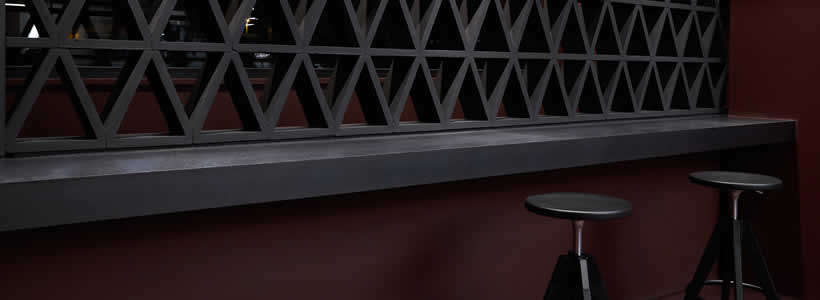
[button link=”https://www.arredanegozi.it/2021/08/emanuele-svetti-progetta-osteria-moderna-di-arezzo/ ” icon=”none” target=”” color=”a30b0b” textcolor=”ffffff”]TESTO ITALIANO[/button]
This story begins with “Once upon a time there was…a tavern”.
The tavern was a meeting point for villagers and a place where travelers could rest. At the tavern, you were never alone since, after all, it is more enjoyable to drink a glass of wine in company than by yourself.
The tavern is a place that recalls ancient times and habits. But now it rises again with a renovated look through a restyling project realized by architect Emanuele Svetti of Studio Svetti Architecture.
The new dining place’s name is Osteria Moderna. It opened at the exit of the motorway of Arezzo the 8th of April 2021. It is a real jewel in the heart of Tuscany and the home city of great poets and scholars such as Vasari, Petrarca, Guido d’Arezzo and Piero della Francesca to mention a few. .
Designed 5 years ago by Studio Svetti Architecture, the design concept is now a sign of hope: “The ideas come out from the darkness to see the light” as the architect said.
This place is designed as a modern tavern intended for those who travel since it is easy to reach. It could also become a reference point for a local clientele.
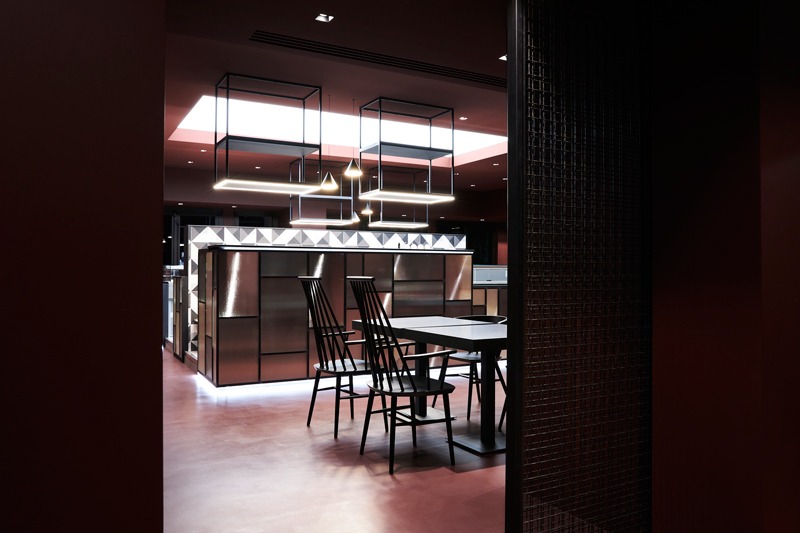
It is indeed designed as a place of memory but it shows also a contemporary taste. “I like designing places that last over time – continued architect Emanuele Svetti – this is the key to success for my design projects in a world where people seek for a successful formula. I like designing places which combines a refined concept and functionality”.
In the Osteria Moderna project, the starting point was amaranth color tone in its warmest and more captivating shade like a beating heart entering the interiors of the tavern fully painted with this color. “a touch of color works better than a bucket of cold water, as Matisse said -explained the architect – red color is appealing and, in some way, ‘attacks’. It’s the best color for an effective visual communication. It’s the color of energy, but also the color of wine in a city where wine is greatly appreciated.”
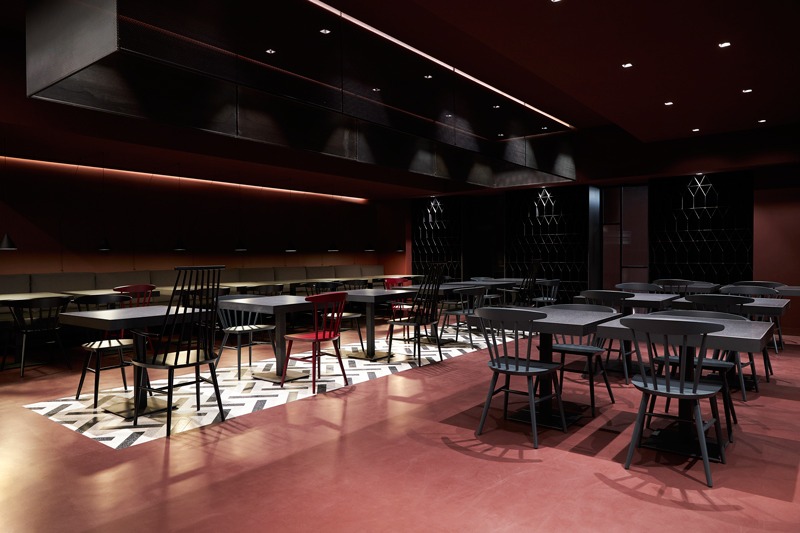
A PLACE OF CONVIVIALITY
The dining place recalls the shapes and layout of a traditional tavern. In the past as well as in Osteria Moderna, there is the “mescita” space which separates those who just want to rest for a short break from people looking for a much longer stay. In old taverns, the dining area was hidden to people passing by and it was also separated from the bar area where people played cards and drank together. In Osteria Moderna, the café area is the first filter with snack corners for fast consumers who can enjoy comfort while having breakfast or just a platter of cold cuts at lunchtime.
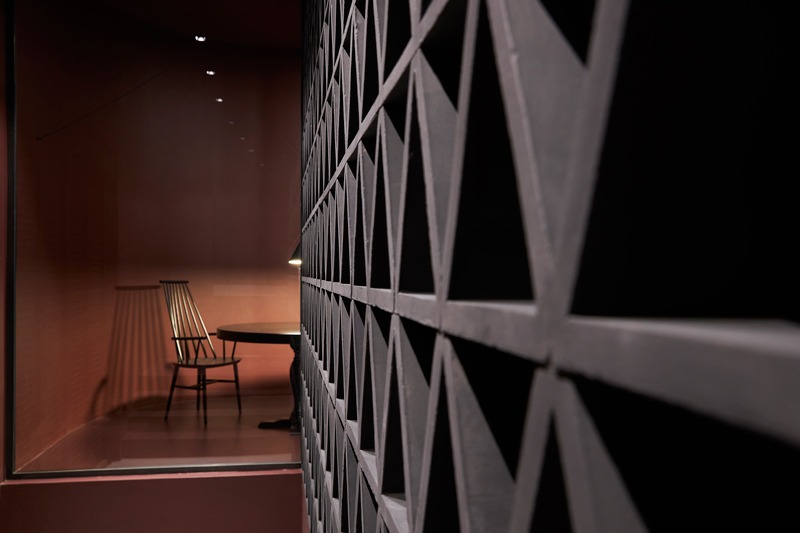
Passing through a system of metal separators, you find the restaurant area where you can dine in an elegant and refined atmosphere characterized by a uniform color with well-balanced, integrated metal elements and concrete inserts.
The place can accommodate 90 guests with a sq. 350 and this could be perceived as a difference from the typical tavern which had a smaller capacity and tight spaces.
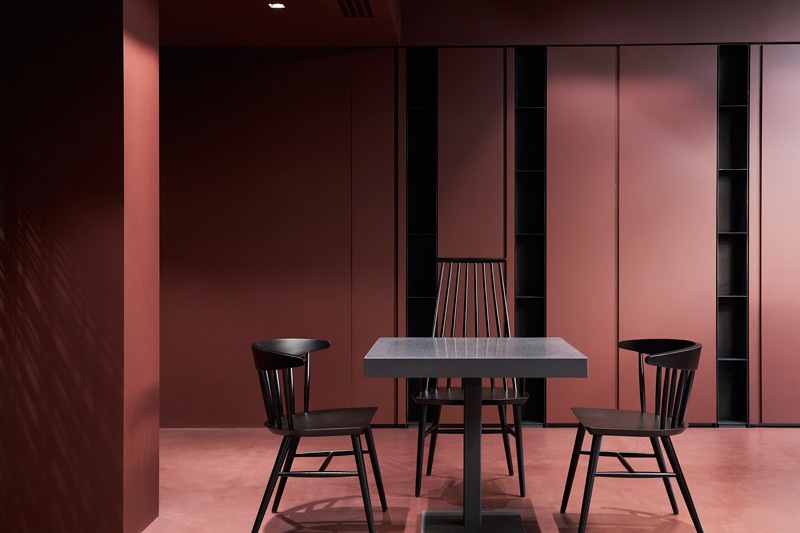
The tavern includes a terrace where people can dine during the warm seasons with furnishings that recall the inside but in a soberer and softer way. The tavern and hostel were traditionally run by a family who managed both businesses alternately during the day. In the case of Osteria Moderna, the family who runs the restaurant completes its offer managing also the Garden Hotel Arezzo situated at the back of the restaurant.
MATERIALS FROM THE PAST
“Sometimes, it is really great to enjoy delicious scents, strong flavors and typical colors” and this is the concept designed for the coverings and floorings. The floor is a continuous surface made with epoxy resin with inserts realized in grit tiles for a Terrazzo alla Veneziana effect to create an unconventional mix of colors and materials. At the center of the restaurant area there is a drawing of cement tiles in three shades of grey which creates an unexpected chromatic variety, but also a point of attraction in the environment because of the sharp contrast choice made by the studio.
Metal tables with strictly minimal lines are combined with a top in grey polished concrete that recall the old furniture of trattorias where wood and marble prevailed. The sizing and positioning of furnishings allow a wide use in the environment, so, according to the circumstances, it could be used as banquet room and it is also in line with all post-pandemic distancing regulations.
Conviviality is also very important to the whole project concept and, hoping for reaching a new normal situation soon, the goal is to achieve a mix of private and social contexts since this is another typical aspect of a tavern.
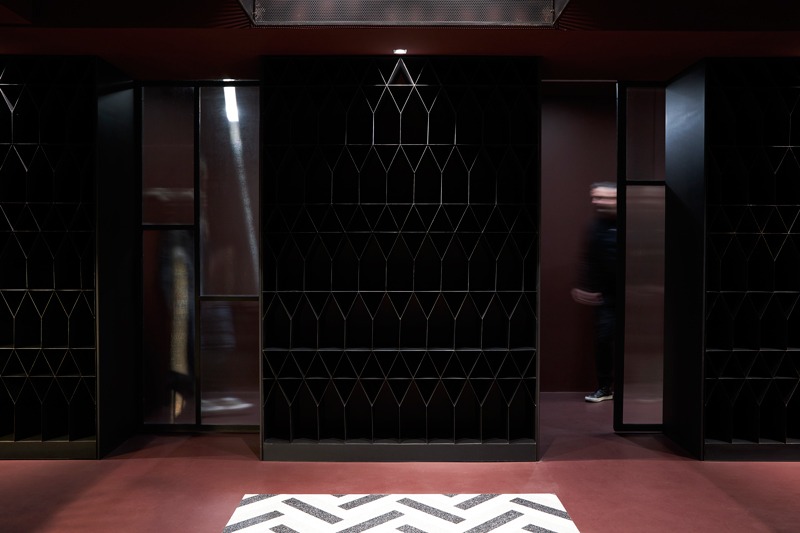
The terracotta colored curtains with specific design, the imposing wine cellar in burnished sheet metal used as background for the restaurant and the balcony covered with silver ribbed glass on a metal frame complete the interiors. Along a wall of the restaurant area, the upholstered seats were realized by an upholsterer to a design by the Studio Svetti Architecture, whereas, with their strict lines, the ArchiStool stools prevail in the snack area.
GAMES OF SHADOWS AND LIGHTS
“Over time, I have learnt how light and shadow are opposite sides of the same coin – the architect said – in fact, when the sun illuminates a place, the shadow comes consequently and, therefore, in my interiors, I include light which is followed by shadow”.
This dialogue between light and shadow recalls the romantic, refined light of candles of country houses. A soft lighting which recalls the ancient places where light was merely functional and rarely aesthetical with clouds of smoke combined with the ethereal vaporous of the kitchen which was often connected to the living room. Al these flavors and scents affect the emotional state of guests who rediscover the memory of Family.
From this point of view, color had a double function of creating a more harmonious environment and, at the same time, of adjusting light on the time of the day to create an extremely relaxing half-light. On the contrary, the café area is very bright: Natural light enters from the windows located along the sides of the building, whereas, during the night, it is replaced by soft artificial light streams which create an intimate and confidential atmosphere.
This contrast between day and night with a play of lights and shadow specifically designed is part of the charm of the place. It is a sort of reinterpretation of the Tuscany spirit which can be seen also in the gastronomic offer that traditional Tuscany dishes with proposals from other cuisines.
Photo credits: Andrea Bartolozzi, Greta Costeri
by AN shopfitting magazine no.163 ©

